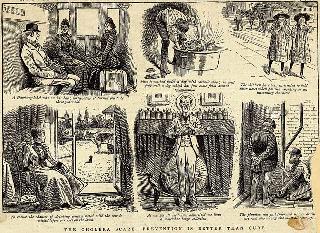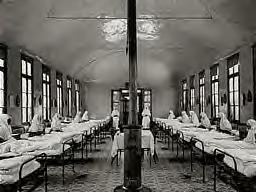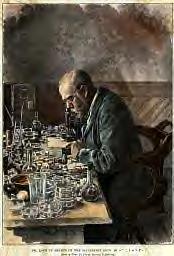Due to the poor environmental conditions, disease in the earlier part of the period ran rampant. As the century progressed and laws passed to correct the health concerns, the death rates of various illnesses began to drop and there were far less instances of "epidemic" proportion. As you go through the following, you'll notice a lot of diseases that will carry themselves through into the 20th century with several abolished due to vaccinations which were developed to prevent them.
Chicken Pox
Chicken-pox is one of the most common of the diseases of children. It appears in the form of little spots, round, not depressed in the centre like those of small-pox. The illness is preceded by symptoms of fever, chills, headache, weariness, and sometimes aching in the back and limbs. Often nothing particular is noticed in the child till the eruption appears as little spots, first over the trunk, and then over the face and limbs. They soon fill with a clear fluid which by the fourth day begins to dry up, in some instances leaving only a slight redness where the pox once appeared.
Chicken-pox has been thought by some to be a lesser onset of small-pox but was proven not to be so. It is its own distinct disease. Neither vaccination nor small-pox protected one from getting chicken-pox; the disease occurring almost exclusively in childhood.
It should be noted, however, that it is very contagious placing other children in the family at risk of catching it.
Cholera
 One of the most dreaded of all diseases, acutely infectious, caused by drinking water from contaminated sources. Cholera causes a slowing in the blood circulation causing the skin to turn blue and shrunken, with inevitable death. Superstitions have one catching cholera simply because one is afraid of it, and that the sun, comets or too much oxygen in the air caused the disease. Others stopped eating fruits and vegetables as a way to keep from getting the disease because they also were believed to be causes.
One of the most dreaded of all diseases, acutely infectious, caused by drinking water from contaminated sources. Cholera causes a slowing in the blood circulation causing the skin to turn blue and shrunken, with inevitable death. Superstitions have one catching cholera simply because one is afraid of it, and that the sun, comets or too much oxygen in the air caused the disease. Others stopped eating fruits and vegetables as a way to keep from getting the disease because they also were believed to be causes.
Diphtheria
Another common childhood disease, highly contagious, is Diphtheria, the formation of a thick gray membrane in a child's throat making it difficult to breathe. Fever and weakness also accompanied the growth and quite often resulted in death.
Robert Koch, a German scientist, studied the disease and determined the "bacillus" bacteria to be the cause. He also determined that as the bacteria flowed through the bloodstream, it damaged cells in the heart. Two medical students took the results of Koch's experiments and were successful in developing an "antitoxin" which would both prevent and cure the disease.
Poliomyelitis
Another disease affecting primarily children, Poliomyelitis, attacks the spinal cord and brain, often leaving a child to wake up and find his limbs paralyzed. Only bed rest appeared to offer any help in lessening the affects of the disease. It won't be until the middle of the 20th century (1952) that an American doctor by the name of Jonas Salk will develop a vaccine for the prevention of the disease.
Consumption
 Consumption or "tuberculosis" is another common cause of death throughout the century. The term consumption was applied as it described the action of the body tissue wasting away.
Consumption or "tuberculosis" is another common cause of death throughout the century. The term consumption was applied as it described the action of the body tissue wasting away.
It is a highly contagious disease and the bacteria which causes it is found to be carried in milk and other foods and sometimes the saliva of a person who has the disease. It was found that only direct sunlight killed the bacteria.
 In 1882, Robert Koch will discover that the bacteria that caused the disease begins as fine granules, barely visible to the human eye which would attach and grow in every organ of the body, including the lungs and the brain, either damaging or destroying the organ.
In 1882, Robert Koch will discover that the bacteria that caused the disease begins as fine granules, barely visible to the human eye which would attach and grow in every organ of the body, including the lungs and the brain, either damaging or destroying the organ.
Smallpox
Another widely feared disease is smallpox. Affecting people of all ages, is especially fatal to young children. Smallpox is caused by a virus which creates small blister-like bumps on the skin and instead the mouth and throat , sometimes swelling causing difficulty in breathing. After catching it, however, and surviving, one does not get it again. This information is used to find a vaccine to prevent the disease.
|
|
|
|
|
|
|
|
Back to Intro/Index or Site Map
| | Family Gallery | Servants Parlour | Tour Home | Typical Day | Etiquette | Shopping Trip | |
| | Victorian Christmas | Victorian England Fun and Games | Ashton Library | Victorian Wedding | |
| | Victorian England Overview | Guest Registry | Honorary Victorian | Tours | |
| | Awards Received | Bibliography | |
| | 1876 Victorian England Home | |
Credits below copyright information |
| Contact
webmaster |
| Copyright
1999-2017 All Rights Reserved - B. Malheiro May not be reproduced in any way without express written permission of webmaster. |
Credits:
Background and buttons are the creation of webmaster, B. Malheiro. These images have been watermarked and are not for use on another site. Site authored by webmaster.